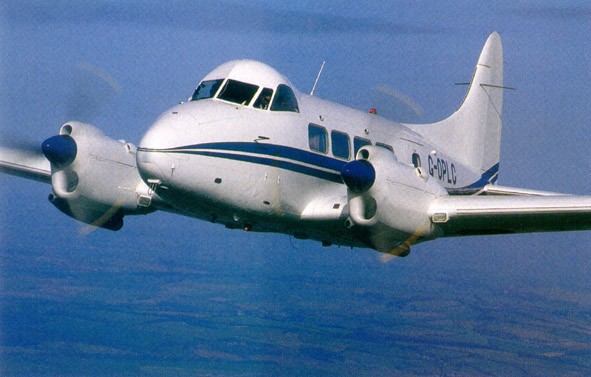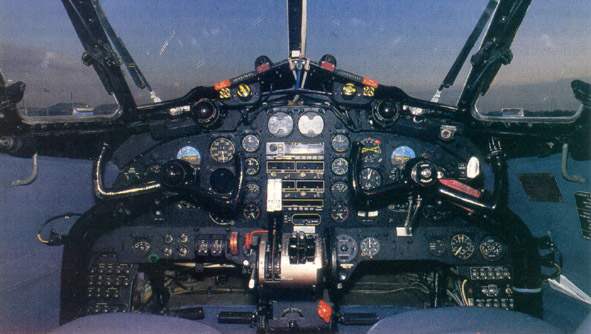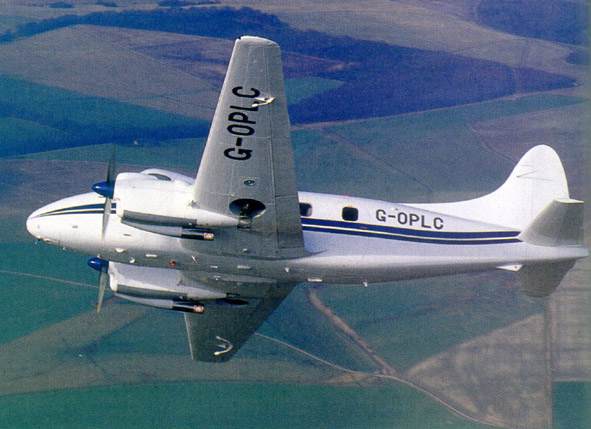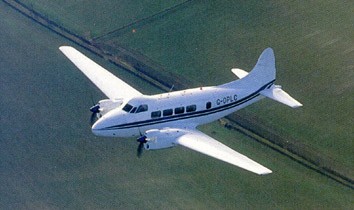207 SQUADRON ROYAL AIR FORCE HISTORY
DEVON VP962 as Lovey Dovey
From an article in FLYER magazine - May 1992: please wait for the page to load

Geoffery Boot wrote: As I spend so much of my time looking at American hardware it was a pleasure to fly something built in Britain. Even from a very cursory inspection it is obvious that this aeroplane was not built to a price for a cost conscious consumer. Although it has recently been refinished externally, you couldn't believe the paint work was covering anything but good, solid British engineering.
The Dove cuts a classic, if slightly dated, line on Farnborough's apron among the executive jets and there is no mistaking the give-away bump at the front which houses the cockpit. Though it can be flown by anyone with a standard PPL (B), the Dove is not a small aeroplane. The wing span is some 57 feet, and the aircraft is 39 feet in length, standing 13 feet high. It was designed and built to a military specification, and is, in effect, a mini airliner. The control surfaces and fins look dated by today's standards, but the construction, based on an all-metal airframe with tricycle undercarriage, is not much different to what one would expect on a decent modern aeroplane.
The control surfaces are fabric covered, presumably to keep weight down. The ailerons have metal mass balances and the elevators attached to the conventional fixed tail plane sport variable size aerodynamic balances on each side to compensate for the asymmetry caused by two propellers turning in the same direction.
The undercarriage is substantial to say the least. The nose wheel and strut would not be out of place on a aeroplane three or four times its size, and the main wheel tyres are enormous, presumably designed for rough or non-paved operations. The undercarriage is operated by a pneumatic air system, and, when parked for any period of time, locks are provided in case the air seeps out. If the aircraft was towed or jarred and the engines were not started to recharge the pneumatic system, then the undercarriage could collapse.
To the front and rear, with external access only, there are two large baggage holds, the forward one being quite capable of housing several sets of (non-magnetic) golf clubs. The rear is still quite cavernous but blocked in part by the bar facility in the main cabin.
Passenger and pilot access is through a large door in the side behind the wing, with a small step ladder. Rather like an airliner, there is a small entrance vestibule which also contains a beautifully concealed w.c., with leather padded seat, and an Edwardian style foldaway vanity basin and bar. Turning left through a bulk head, you enter the main cabin which has a club four layout, with courtesy tables.
Then there is a small step over the main spar to two further seats facing forward. The whole area is beautifully appointed in leather and has distinctive feel of quality about it. There is a small door through a further bulkhead and you enter the cockpit where there are two pilot's seats.
Look down at the main panel, and you could be in almost any reasonably modern aeroplane. The complete flight panel of this resurrected Dove has been retrofitted with new King units, Gyros and HSI, duplicated flight instruments, a slaved Trimble GPS and 3M storm scope. There is a further avionics panel in the overhead above each pilot position. By the left seat lower down there is a board of circuit breaker switches, a forerunner of the pop fuses we now take for granted, and probably a lot easier to use and identify as being tripped. On the other side, lower down on the right is a series of conventional fuses.
The windows and control column give away the aircraft's vintage. The windows are made of 'real' glass and are of the small, flat type, manufactured before the era of moulded perspex. The two massive control columns which spring from the side of each pilot would not look out of place on a 707. Another give-away is the windscreen wipers, not something you are likely to find on a Piper or Cessna.
Once you are seated in the pilot's position, the large three-blade variable pitch propellers look amazingly close, and the engine cowlings very obviously don't house your conventional Lycomings or Continentals. Hiding under the beautifully sculptured but unusual shaped cowlings are two Gipsy Queen 70 Mark 3, six-cylinder in line 400 hp engines, mounted inverted. The tiny exhaust pipes are housed in what the manual apologetically calls thrust augmentors which look rather like rocket attachments to the bottom of each nacelle.
During the walk round I was surprised to see what appeared to be thin lines of gauze cut into the leading edge of the wing and tail plane. These turned out to be de-icing strips utilising TKS fluid, standard I am told on a 1948 aircraft. How's that for progress? Piper and Cessna seem to have stepped backwards with rubber boots. Only now are we finding TKS de-icing applications on smaller US twins, and some new singles.
The Dove is no lightweight, weighing in at some 9,150 lbs, some 2,000 lbs or so heavier than a Piper Chieftain, which in reality means that empty, plus two pilots equals 7,100 lbs leaving just over 2,000 lbs worth of pay load. The maximum landing weight is some 8,625 lbs, which means that the passengers either have to sweat a lot or at least 525 lbs of that lost weight must be fuel. In practical terms, this equates to two pilots, four passengers, full fuel and around 190 lbs of baggage, which equals 500 miles with IFR reserves.
Obviously you can juggle with the load and carry more passengers and baggage with less range. RSJ operate the aircraft in the Public Transport Category. They believe it is probably the only Dove operated this way in Europe, offering an opportunity for members of the public to sample the elegance, comfort and luxury of yesteryear. The aeroplane is still a practical form of transportation offering luxury airliner comfort for a special occasion. You could fly to say Northern France for a day's golf or perhaps it might be the ideal way of starting a honeymoon - a lot more romantic and memorable than a trip out of Gatwick.
Back at the business end, with RSJ's chief pilot Peter Manley I had a sneaky suspicion that all that cold 400 hp might prove difficult to start. I couldn't have been more wrong, a quick dab at each starter, and both engines were soon running, and the generators on line. Everything runs on pneumatics with a pump powered from each engine. With each dab at the brakes the aircraft huffed and puffed like an old steam train. There are pneumatic gauges to the left of the left seat position, and two tanks up front which store surplus air, at around 500 lbs per square inch.

Things around the cockpit are not quite as ergonomically placed as they are in modern aircraft. But though old fashioned, the Dove's cockpit is quite functional and contains some quite innovative features. Brakes are only operable from the Pl position and are column mounted. There is a small lever leading out from the central column which you press with your left thumb - the effort is minimal since everything is pneumatically operated. The brakes will operate on the left wheel when left rudder is depressed, right wheel when right rudder depressed, and if the rudders are even, then on both wheels. This can be locked on as a park brake.
Although it took a little bit of getting used to while taxying, the system is very effective, and it needs to be since the nose, wheel is free castoring. Steering is thus via the rudder at anything above 30 to 40 knots and brake assisted below.
The central quadrant sprouted two power levers and two prop levers, but no mixture levers where I thought they belonged. There are fuel cocks but mixture to the engine is controlled automatically. Apart from full power operations when the power levers are brought back, there is a weak section marked on the quadrant and the engines will then automatically adjust to provide optimum mixture for altitude.
Another oddity is that, although the RPM levers come back to the feathered position, the propellers do not automatically feather. There are two buttons above the panel which need to be depressed to fill the accumulators to achieve full feather. The RPM levers are also limited in forward movement by gates, as rumour has it that the props would go into reverse thrust. How's that for innovations on a 1948 aeroplane? There are also two fire buttons to operate the fire extinguishing system.
The engines are super-charged, and that's not the same as turbo-charging. Instead of normal manifold pressure gauges there are two small gauges which register boost, from minus two, to plus eight, plus six being the normal operating level, along with two RPM gauges which would have looked more at home on a 1-11, with a large outer scale calibrated in hundreds, and two smaller inner dials for the thousands.
Visibility from the cockpit forward and sideways is good. There are two small windows, one on either side, for ventilation, very much needed as the small glass windows were only too happy to steam up. Heating is courtesy of ram air, and a defrost lever does not seem to have been invented in the 1940s.
Once the art of steering the aeroplane with the little pneumatic brake is mastered, ground handling was no different to any other aeroplane. Even though both of the large three blade propellers rum in the same direction, with max. boost applied, the aircraft ran straight on the runway after a little wobble, with the combined 800 hp producing a very audible growl. We quickly accelerated to a rotate speed of 77 knots, followed by blue line best single engine rate of climb speed of 86 knots.
VMC is comfortably low at 65 knots, well below rotate speed, and although single engine performance at max. all up on a standard day is not what you might call outstanding at 86 knots, the aircraft will still climb at 150 ft per minute. The climb speed can be adjusted from anything around 90 to 130 knots. At 110 we were getting around 2000 ft per minute, and that's with two pilots, four people and three quarters fuel. At 130 knots, which Peter tends to use as a normal climb, through to around 8000 feet, we were turning in a respectable 1000 ft a minute. Above 8000 ft Peter adjusts the speed back to 120 and then the climb rate falls away, as super chargers are not like turbochargers and manifold pressure peaks out depending on the ambient pressure at around 8000 ft. Take-off runs are quite acceptable, with a distance of some 2,500 ft needed on a standard day, to take-off to 50 ft, at max. all up. Landing at maximum weight from 5Oft takes some 1950 ft.
This is no pressurised aeroplane, and Peter reckons the optimum altitude to produce best economy and best true airspeed is around 8000 ft, so I was interested to see how much fuel 800 hp worth of engines was going to consume in the cruise. At 3000 ft we levelled off with the throttle back to two inches of boost at 2200 rpm. We settled at 150 knots and around 25 to 28 Imperial gallons per hour.
By increasing the boost to around 6 in. the speed increased to 170 knots and 30 to 35 gallons per hour, which is not bad bearing in mind the size of the engines. A Cessna 340, for instance, with nearly 200 hp less for a similar airspeed at similar altitude burns approximately the same. Of course the comparisons stop there because aeroplanes like the 340 and 421 are pressurised and so have the ability to climb above the weather where the thinner air gives better true airspeeds and more econom, ical fuel bums can be achieved.
I was very impressed, and have to say pleasantly surprised, by the smooth, quiet cruise. This was due, no doubt, in part to the excellent refit which incorporated sound dampening material, but some credit should be given to the very smooth running Gypsy Queen engines. The aeroplane seemed very stable. The elevator trim proved very positive and highly geared. This made trimming quite easy, which is good news as the aircraft has no autopilot. The ailerons proved quite heavy, and with fairly poor roll response of probably no more than 20 degrees per second.
The elevators by contrast were somewhat light. There was little requirement for rudder, apart from during engine out work, in which case it is very fortunate that there is a positive wind on the rudder trim as the loads during a simulated engine failure after take-off are quite high.
However the aircraft proved very controllable and, apart from the lack of conventional mixture and the need to carry out a secondary feather drill to ensure you press the manual button, proved no more difficult to handle than a modem aeroplane. During engine-out operations, the engines, which are rated at 3000 rpm maximum, are able to operate at 2,800 rpm and plus six boost continuously which returns a single engined cruise of around 110 knots.

While this is not an aeroplane built for throwing around the sky, I was interested to see how yesteryear technology compared in terms of ability to bite. I was once again pleasantly surprised when we reduced the power and brought the aircraft back to the stall, almost a non event with little tendency for wing to drop and easily recovered by easing the column forward.
Even with part flap and the undercarriage down there was no tendency for the wing to drop. Forward pressure on the column brought about almost instant recovery. The speeds were 68 knots without flap, 64 with 20 degrees of flap and 57 with full flap and gear down. This is not very fast for an aircraft weighing 9,150 Ibs and somewhat better than most latter day equivalents.
Returning to Farnborough, Peter demonstrated the engines' flexibility by bringing back the power quite dramatically in the descent, somewhat more quickly than I would have risked on a modern Continental engine. Perhaps they knew more about shock cooling than we do?
We flew round the circuit at a very sedate 100 knots, dropping the undercarriage and 20 degrees of flap aiming for the threshold at around 85 knots. Peter tends to use only 20 degrees of flap although up to 60 are available. Coming over the threshold power can be brought right back and the aircraft checked and allowed to settle very gently on the ground.
The gear limiting speed is some 135 knots, as is flap limiting for 20 degrees, which means that gear and flap can be used to slow the aircraft down coming into the circuit. The crosswind limit is a quite reasonable 22 knots, although I would imagine that as the speed deteriorated one would have to be fairly proficient with the pneumatic brake to maintain direction with a crosswind of that order.

So, as a modem day graduate of the Piper and Cessna school of flying, what did I think of this rival from the past? To be frank, I was spoiled by a very gold plate introduction to the type. G-OPLC must be about the most luxuriously and well fitted Dove in the world. But for all the gloss, underneath the paint you cannot change the basic aeroplane and the way it performs.
If I'm honest, I did expect the Dove to be a bit of an old crock from the forties and fifties. In reality I was confronted with an aeroplane, that although obviously old fashioned, is not so outdated that it is awkward to fly, and also one that performs very well compared to its modern counterparts.
Everything about the Dove seems to be over-engineered by today's standards. If the aircraft were to be built again and modernised a fair old sum could be saved just by using smaller components that would quite adequately do the job. The nosewheel and columns are just two items that spring readily to mind. Maintenance costs can only be guessed at, but for any aircraft of this vintage they cannot be cheap. But the fuel burn is by no means astronomical, bearing in mind the size of the engines, and I can understand why a small number of Dove devotees are now bringing the old girl back onto the private register in various parts of the world.
Only a couple of weeks after flying Farnborough's Dove, we came upon another newly-restored flying Dove at Lelystad in Holland, Amsterdam's equivalent of Biggin Hill, and the stars in the eyes of those Dutch owners said everything about the glamour of this old beauty.
It is a crying shame that Britain's aircraft designers and companies could not come up with more modern designs to fulfil the kind of promise made by aircraft like the Dove. Had they moved forward with modern techniques and designs from the innovations already apparent in this 1948 aircraft, I'm sure that we could have been there with a scaled down Dove that would have competed on the world stage.
That was, alas, never to be. From 1945 to 1950 more than 300 Doves were built and sold in thirty countries and the type remained in production for nearly 21 years. There are still quite a few throughout the world, some still in their military role, others doing civilian work. We are left with only a handful in the UK and these are now becoming novelty collectors' items.
Rather like our memories of the British light aircraft industry.
DE HAVILLAND 104 DOVE MK 8
| Engines: | 2 Gipsy Queen 70 Mk
3, six cylinder line, 400 hp each |
| Vne | 206 kts |
| Vno | 130 kts |
| Vfe 20 deg | 135 kts |
| Vfe 60 deg | 109 kts |
| Wing span | 57 ft |
| Length | 39 ft |
| Height | 13 ft |
| Wing area | 335 sq. ft |
| Maximum range VFR | 640 miles |
| Maximum range IFR | 475 miles |
| MAUW | 9,150 lbs |
| Usable load | 2,059 lbs |
| Maximum fuel | 168 gallons |
| Maximum ceiling | 10,000 ft |
| Baggage load rear | 600 lbs |
| Baggage load front | 300 lbs |
| Landing
distance (private category) from 50 ft |
1,960 ft |
| Landing
distance (public category) from 50 ft |
2,800 ft |